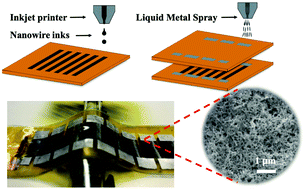Flexible thermoelectric generators with inkjet-printed bismuth telluride nanowires and liquid metal contacts†
Abstract
Solution phase printing of nanomaterials is becoming increasingly important for the creation of scalable flexible electronics including those associated with biomedical and energy harvesting applications. However, the use of solution-phase printed thermoelectric energy generators (TEGs) has been minimally explored. Herein we report a highly flexible inkjet-printed TEG. Bismuth telluride (Bi2Te3) and bismuth antimony telluride (Bi0.5Sb1.5Te3) nanowires (NWs) are inkjet printed onto polyimide to form n-type and p-type legs for the TEGs. A post-print thermal annealing process is used to increase the thermoelectric performance of the printed NWs while eutectic gallium–indium (EGaIn) liquid metal contacts electrically connect the TEG legs in series. Annealing conditions for the combination of p/n legs are examined to maximize the thermoelectric efficiency of the TEG prototype. The maximum power factor was found to be 180 μW m−1 K−2 and 110 μW m−1 K−2 for the Bi2Te3 and Bi0.5Sb1.5Te3 nanowires respectively. A maximum power for the fully printed TEG device measured 127 nW at a 32.5 K temperature difference. The performance of the TEG device does not diminish even after multiple bending experiments (up to 50 times) around a tight radius of curvature (rod-dia. 11 mm). Hence this inkjet-printed flexible TEG is a step towards a fully functional wearable TEG device.

- This article is part of the themed collection: Editor’s Choice: Thermoelectric nanostructures


 Please wait while we load your content...
Please wait while we load your content...